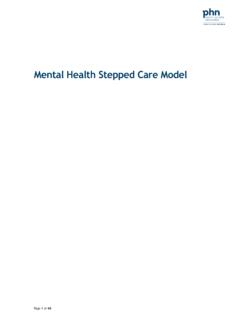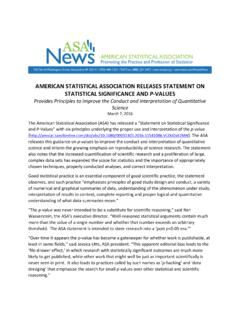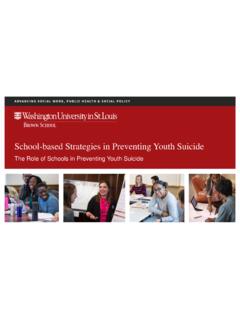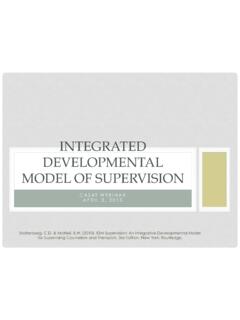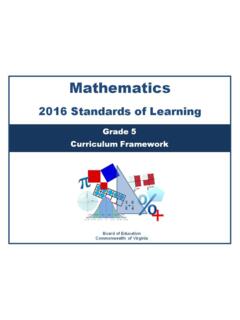Transcription of Effective Grading: A Tool for Learning and Assessment
1 Effective Grading: A Tool for Learning and Assessment Barbara E. Walvoord and Virginia Johnson Anderson A Review by David Adams Walvoord, Barbara E. and Virginia Johnson Anderson. Effective Grading: A Tool for Learning and Assessment . San Francisco: Jossey-Bass, 1998. Grading is a powerful tool faculty use to communicate with their students, colleagues, and institutions, as well as external entities. The authors, through their personal experiences in the classroom and from listening to faculty from myriad institutions at workshops around the country, have found that teachers have spent nearly every day of *their+ teaching lives wrestling with the problems, the power, and the paradoxes of the grading system (xv). Effective Grading .. presents suggestions for making classroom grading more fair, more time-efficient, and more conducive to Learning (xvi). In addition, the authors provide a number of means and examples for using grading as a way for faculty, departments, and institutions to assess Learning outcomes a process required by regional accreditation agencies and many state legislatures.
2 Walvood and Anderson admit that their Assessment model, or system, has tradeoffs. Essentially, the system requires wide participation from faculty, and it requires faculty time to reevaluate their classroom practices, improve them as needed, and make them visible in new ways (154). The benefit the authors purport is more faculty control over outcomes Assessment in their own classroom by using the grading process, and the Assessment conducted through grading can be integrated easily with Assessment plans that already exist in departments and institutions. It is the authors' hope that faculty will be able to maintain maximum control over curricular content; over the teaching, Learning , and grading process in classrooms; and over the tests, assignment, criteria, and standards by which faculty assess student Learning (154). Through the use of case studies and examples, Woolvard and Anderson provide new ways to think about and conduct grading and the many ways this information can be used to assess Learning outcomes.
3 The authors acknowledge that many accrediting agencies warn that you can't use grades for Assessment and there are many problems that attend the grading system. But the grading process, when well employed by skillful teachers, can yield rich information about student Learning (xvi-xvii). To make grading useful for departmental Assessment : Grading must be understood as a process that identifi[es] the most valuable kinds of Learning in a course, construct[s] exams and assignments that will test that Learning , set*s+ standards and criteria, guide*s+ students' Learning , and implement*s+ changes in teaching that are based on information from the grading process. (xvii). To this end Walvoord and Anderson organized their book into two sections: The first deals with grading in the classroom and the second addresses how grading can serve broader Assessment purposes. Part One helps faculty understand grading processes and offers techniques and advice to make it more beneficial to themselves, their students, their department, their institution, and ultimately the public.
4 Part Two builds on the knowledge of these processes and demonstrates how these techniques can be -1- used easily for outcomes Assessment . A case study and appendices are provided to help faculty and administrators better understand how grading can be used as a tool for Assessment . Grading is the process by which a teacher assesses student Learning through classroom tests and assignments, the context in which good teachers establish that process, and the dialogue that surrounds grades and defines their meaning to various audiences (1). Grading serves four roles: 1) it Evaluates the quality of a student's work; 2) it Communicates with the student, as well as employers, graduate schools, and others; 3) it Motivates how the students study, what they focus on, and their involvement in the course; and 4) it Organizes to mark transitions, bring closure, and focus effort for both students and teachers (2).
5 This is the reason grading is so important for the Assessment process . principally in the minds of faculty. The authors, along with many institutions and accreditation agencies, however, believe that grades in themselves, particularly final course grades, may be isolated artifacts . which are neither useful nor appropriate for institutional Assessment needs. It is therefore not the actual grade that is useful for Assessment but the grading processes (4). The authors assert that bridges exit that can help *faculty and administrators+ link classroom grading processes to departmental and general education Assessment (5). The Classroom Assessment Classroom Research model proposed by K. P. Cross and others is any systematic inquiry designed and conducted for the 1. purpose of increasing insight and understanding of the relationships between teaching and Learning .. This model can help the teacher use the grading process as a systematic collection, analysis, and use of data about student Learning to assess and improve the course.
6 The challenge for Effective Assessment is to manage the grading process. To do this faculty must abandon three common false hopes that belie the context and the complexity of the grading process: 1) The false hope of total objectivity in grading; 2) The false hope of total agreement about grading; and 3) The false hope of a one-dimensional student motivation for Learning (10). To do this the authors provide twelve principles for managing the grading process. 1. Appreciate the Complexity of Grading; Use It as a Tool for Learning Grading is a socially constructed and context-dependent process, and no grade or grading system is immutably right by some eternal standard (10). The role of grades can change over time and they have different meaning for different groups of people. 1. Cross, K. P. Classroom Research: Helping Professors Learn More about Teaching and Learning . In P.
7 Seldin (ed.), How Administrators Can Improve Teaching: Moving from Talk to Action in Higher Education. San Francisco: Jossey- Bass, 1990. -2- There are four major roles of the grading process evaluation, communication, motivation and organization. 2. Substitute Judgment for Objectivity There is no absolutely objective evaluation. The teacher must develop and render an informed and professional judgment within the context of the institution, students, and their future employees. 3. Distribute Time Effectively Spend enough time to make a thoughtful, professional judgment, with reasonable consistency, then move on (11). Repeatedly reviewing work does not lead to perfect objectivity. 4. Be Open to Change Your grades and grading system will be interpreted and used within the system that is not the one you wish for or the one you experienced as a student (12). The social meaning of grading changes over time.
8 Be open to change but careful of grade inflation. 5. Listen and Observe Students attach a meaning to grades that will most affect Learning . Be clear with the students about these meanings. In establishing grades .. you are invoking a set of cultural beliefs and values that will shape the Learning potential of your grading process. The better you understand the culture, the better you can manage the grading process (12). 6. Communicate and Collaborate with Students Explain the criteria and standards you hold for their work and seek their active engagement in the Learning process (13). Collaborate with the students to work toward common goals. 7. Integrate Grading with Other Key Processes Make grading integral to everything else you do. 8. Seize the Teachable Moment Informal feedback and discussion about grades is good for students. Emotional moments can be valuable teaching moments in which lessons and values can be imparted to your student.
9 9. Make Student Learning the Primary Goal Values can clash between internal and external forces. When they do teachers need to remember to hold Learning , rather than reporting to outsiders, as the most important goal of grading (14). More student involvement leads to more Learning and personal development. Their involvement in Learning is in part determined by their perception of faculty members' interest and friendliness toward them, including the fairness and helpfulness of the testing and grading system and the teacher's communication about their work and their grades (14). Good Practice in Undergraduate Education2. 1) Encourages student-faculty contact 2) Encourages cooperation among students 3) Encourages active Learning 2. Chickering, A. W. and Z. F. Gamson. Seven Principles for Good Practice in Undergraduate Education. AAHE. Bulletin, 1987, 39(7), 3-7. -3- 4) Gives prompt feedback 5) Emphasizes the time the student devotes to the task 6) Communicates high expectations 7) Respects diverse talents and ways of Learning 10.
10 Be a Teacher First, a gatekeeper Last Understand the student, believe in them, figure out what they need, and help them learn no matter their background. Provide all students and equal chance to learn. 11. Encourage Learning -Centered Motivation Motivation is a key to Learning and grades have the ability to provide this motivation to an extent. Attitudes towards grades, more than the grades themselves, negatively affect student's motivation to learn (16). 12. Emphasize Student Involvement This is the bottom line for Learning . All of these suggestions provide a focus for faculty attention and energy; they do not, however, eliminate the problems with the grading system. If faculty construct grading systems that are conducive to Learning they can create and generate information that can be useful for Assessment of Learning outcomes. The challenge then is to create and select assignments and exams that will both teach and test the Learning you most care about (16).

